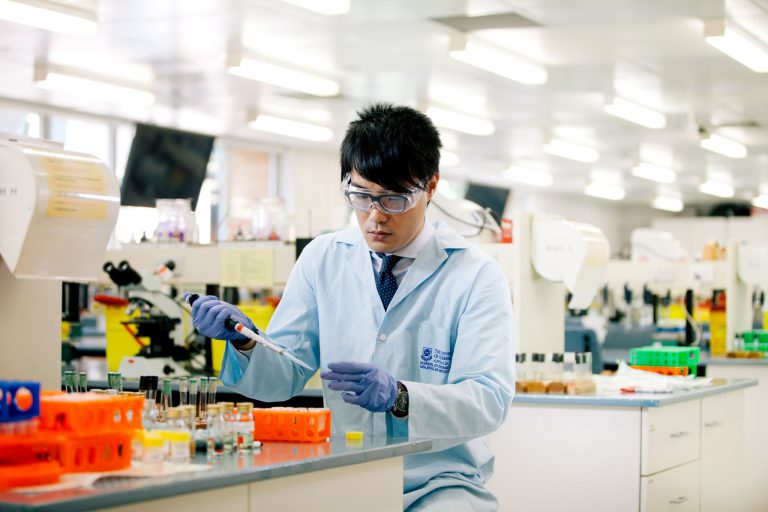
While the names of Nobel Laureates are often well-known, what is often less recognized is that many of these winners would have been unable to complete their ground-breaking work if not for the close working relationships or partnerships that they had with universities around the world. Universities and colleges are often the prime generators of Nobel Prize winners due to their purposefully creating environments that help foster and inspire innovative thinking and risk-taking that is difficult to replicate outside of the academic community.
Studying science is about much more than receiving a degree on a piece of paper, it is about having the chance to study the world deeply and to have profound effects upon that world. Below we look at a sampling of Nobel Prize winners whose work changed the world and who were able to conduct their research and experiments at universities and colleges.
Sir Robert Geoffrey Edwards – In-vitro Fertilization
Robert Edwards won his Nobel Prize in Physiology / Medicine for his development of in-vitro fertilization. The process involves fertilizing an egg in a laboratory outside of the woman’s body, then culturing the egg for up to six days before implanting it in the woman’s uterus so that she can have a successful pregnancy.
Edwards originally came up with his idea for in-vitro fertilization while working at the National Institute for Medical Research in London, however, he received little financial support and his work was stymied. Eventually, Edwards ended up at the University of Cambridge and began again on his work. The university, in partnership with Oldham and District General Hospital in Oldham, agreed to provide ethical support and funding to the research. If it was not for this strong support from the university, Edwards may never have achieved his goal of developing in-vitro fertilization.
The Edwards’ procedure is a scientific break-through that has had a huge impact on society of the wellbeing of millions of families worldwide.
Andre Geim and Kostya Novoselov – Graphene
It might be surprising to learn that two Russian researchers at the University of Manchester discovered the extraction process for the world’s thinnest metal in 2004. Andre Geim and Kostya Novoselov were eventually awarded the Nobel Prize in Physics in 2010 for “ground-breaking experiments regarding the two-dimensional material graphene”. The two researchers were respectively the 24th and 25th Noble Prize winners in the history of the university.
Geim and Novoselov’s discovery came about as a result of one of their weekly “Friday night experiments” – a time when the duo would experiment with new ideas even if they were not directly linked to the rest of their research. These experiments were but one of the many benefits of working in the University as opposed to the private sector (not often known for allowing unstructured risk-taking).
Graphene is now one of the key materials in many types of nanomaterial, such as carbon nanotubes.

Dorothy Mary Hodgkin – Protein Crystallography
In 1964, Dorothy Hodgkin, a British biochemist at the University of Oxford, was awarded the Nobel Prize in Chemistry. Hodgkin was awarded the honour due to her pioneering work in developing protein crystallography. In particular, she advanced the method of X-ray crystallography – a tool used for identifying the atomic and molecular structure of a crystal, in which the crystalline atoms cause a beam of incident X-rays to diffract into many specific directions.
In 1960, Hodgkin was named as the Royal Society’s Wolfson Research Professor. This position allowed her the freedom to conduct her research and experiments at the University of Oxford for the next two decades. Again it was the academic freedom provided to her by the University that was a key part of her discovery.
X-ray crystallography has now become a widely used scientific tool for determining the structure and function of biological molecules.
The success of those above all started with studying science at university. Science makes a positive impact on people’s lives and in many cases, science saves lives. Scientists use their expertise to develop real solutions for real problems taking on many challenges facing our world.
Read on for more information on leading institutions who offer world-class science programmes:
UNIVERSITY OF QUEENSLAND FACULTY OF SCIENCE – AUSTRALIA
The University of Queensland (UQ), located in Brisbane, is one of Australia’s largest and most well established universities. UQ is ranked among the world’s top 100 universities and is one of only three Australian members of Universitas 21, a leading network of research universities for the 21st century. UQ’s Faculty of Science, based across the university’s St Lucia campus and Gatton campus, offers students one of the widest choices of science disciplines in Australia. The Faculty accommodates approximately 1,100 full-time staff and 7,500 full-time students and is ranked in the world’s top 20 universities for environmental sciences, biological sciences, agriculture and forestry. Read the full profile…
HEALTH SCIENCES, CURTIN UNIVERSITY – AUSTRALIA
Curtin University, located in Perth, is Western Australia’s largest and most multi-cultural university with over 16,000 enrolled international students from 120 countries. Curtin’s Faculty of Health Sciences is one of the largest and most comprehensive health schools in Australia and South-East Asia. The Faculty educates more health professionals than any other Western Australian tertiary institution. Curtin’s professional degrees are nationally accredited and internationally recognised, with strong industry links and extensive hands-on clinical/fieldwork experience that enables graduates to be career-ready and internationally employable. Read the full profile…
COLLEGE OF SCIENCE, MCNEESE STATE UNIVERSITY – USA
With a growing international student population comprising over 300 students from more than 41 countries, McNeese State University is dedicated to enabling students from all corners of the globe to achieve their educational goals. An institution founded on the belief that excellence and affordability go hand in hand, McNeese has been ranked in Tier One of the Best Regional Universities-South category of the US News & World Report for two consecutive years. The primary purpose of the University’s College of Science is to provide accessible, high-quality tuition at undergraduate and postgraduate level. In addition to its standard course options, the College is responsible for providing students with the additional learning opportunities they require to meet and exceed their academic, personal and professional goals.
COLLEGE OF SCIENCE, UNIVERSITY OF NOTRE DAME – INDIANA, USA
The University of Notre Dame du Lac is located near South Bend, in Indiana. It is organised in five colleges and welcomes around 8,000 undergraduate students. Founded in 1965, the University of Notre Dame’s College of Science today relishes an international reputation for the quality of its international resources and its state-of-the-art infrastructure. The University has a strong Catholic character and the college’s mission is to prepare tomorrow’s scientific leaders. Programs at the College involve basic sciences, chosen advanced science and the humanistic and social studies including theology and philosophy.
FACULTY OF SCIENCE AND ENGINEERING, JAMES COOK UNIVERSITY – AUSTRALIA
Globally recognised for the quality of its teaching and research programs, Australia’s James Cook University (JCU) offers students the opportunity to study, undertake research and gain qualifications in a stunning, unique location. JCU is ranked among the top 4% of universities in the world in the Academic Ranking of World Universities (ARWU) 2014 and is renowned for producing students with a special understanding of the tropics. The institution has the unrivalled natural advantage of being located close to the wet tropic rainforests, the dry savannahs and the ocean simultaneously, which enables students to work within remarkably varied environments.







